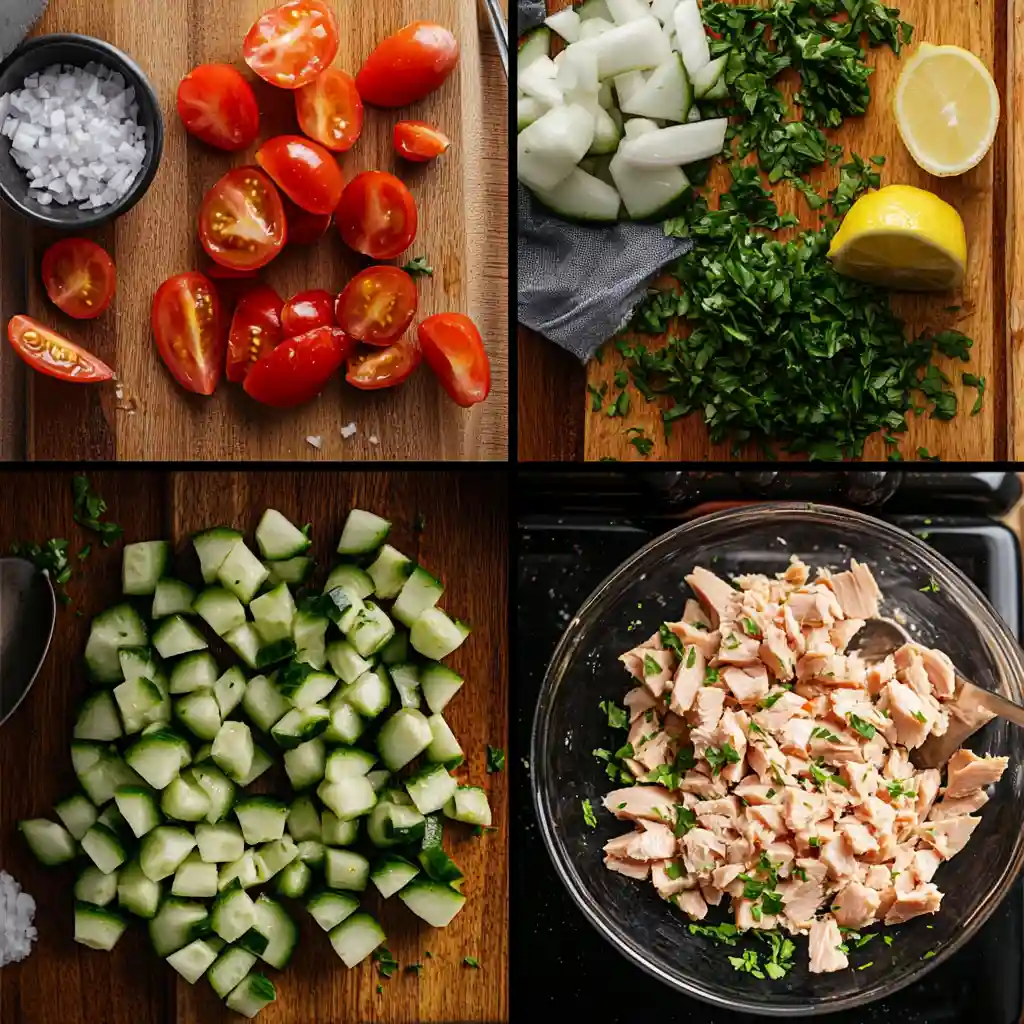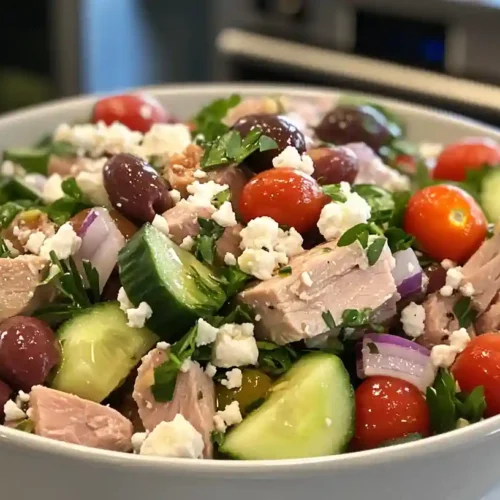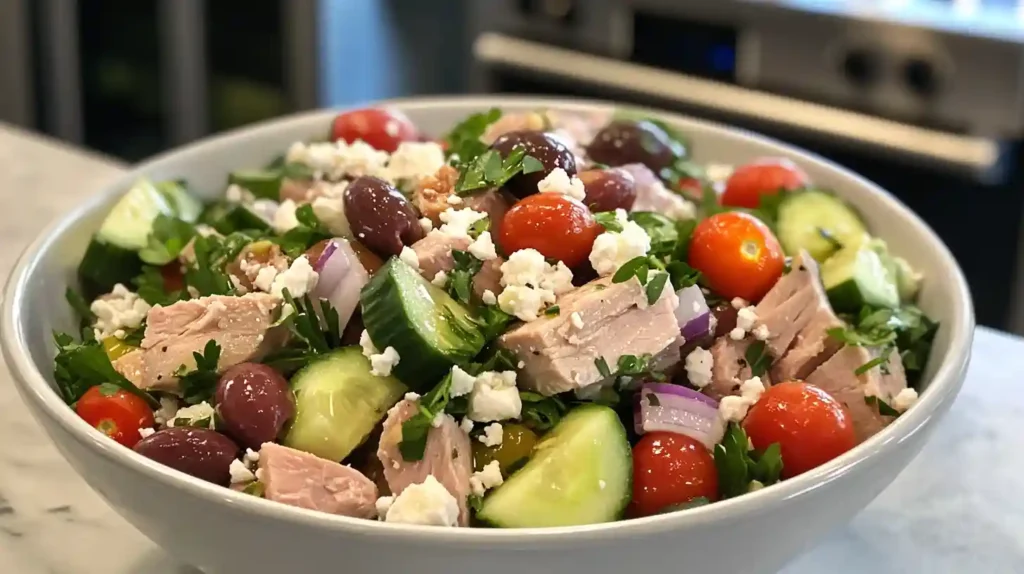Are you looking for a simple yet delicious salad that combines fresh ingredients and Mediterranean flavors? Our Mediterranean Tuna Salad Recipe is exactly what you need! Whether you’re on a health kick or just craving something flavorful, this salad is perfect for lunch or dinner. Read on to discover the best Mediterranean tuna salad recipe that you can easily make at home.
Benefits of Mediterranean Cuisine:
Mediterranean cuisine is known for its emphasis on fresh, whole ingredients like vegetables, olive oil, fish, and lean proteins. It’s celebrated not only for its delightful flavors but also for its health benefits. Rich in healthy fats, fiber, and antioxidants, a Mediterranean diet can promote heart health, improve digestion, and help manage weight. Incorporating ingredients like olive oil, fresh vegetables, and tuna into your meals ensures that you’re fueling your body with nutrient-dense foods that support overall wellness.
Tuna as a Versatile, Protein-Packed Ingredient:
Tuna is a star ingredient in many Mediterranean recipes, thanks to its high protein content and versatility. Whether you use canned tuna or fresh tuna steak, it provides a lean source of protein, which is essential for building muscle and maintaining energy throughout the day. It’s also rich in omega-3 fatty acids, which are known to support brain health and reduce inflammation. Whether you prefer the ease of canned tuna or the heartiness of grilled tuna, it’s a great addition to any Mediterranean meal.
Different Versions of the Mediterranean Tuna Salad Recipe:
This Mediterranean Tuna Salad Recipe is highly versatile, and you can make it to suit your personal preferences. For a classic version, you can mix in a bit of mayonnaise for a creamy texture. However, if you’re looking for a lighter, healthier option, you can skip the mayo and make it mayo-free, relying on olive oil and lemon juice to enhance the flavors. Either way, you’ll enjoy a fresh, satisfying dish that’s bursting with Mediterranean goodness.
Table of Contents
History of the Mediterranean Tuna Salad Recipe
Mediterranean Diet and Its Influence on Salads
The Mediterranean diet, rooted in the traditional eating habits of countries bordering the Mediterranean Sea, is celebrated worldwide for its health benefits. This diet emphasizes the consumption of fresh fruits and vegetables, whole grains, legumes, nuts, and olive oil, with moderate amounts of fish and poultry. One of the cornerstone meals of the Mediterranean diet is the salad, a dish that incorporates a variety of fresh, nutrient-rich ingredients, often combined with the healthful fats of olive oil and the zing of lemon juice.
Salads in the Mediterranean are typically light yet packed with flavor, making them an ideal choice for those looking to maintain a healthy lifestyle. The simplicity of Mediterranean salads allows the natural flavors of fresh ingredients to shine through, while providing a rich source of vitamins, minerals, and antioxidants. The Mediterranean tuna salad fits perfectly into this pattern, offering a healthy, protein-packed option that can be enjoyed as a light lunch or a main meal, while supporting heart health, weight management, and overall well-being.
Origins of Tuna in Mediterranean Cuisine
Tuna has long been a staple in Mediterranean cuisine, especially in coastal regions where fishing is a key part of the local economy and culture. Historically, tuna was prized not only for its nutritional value but also for its versatility. In ancient Greece and Rome, tuna was often used in stews and other hearty dishes, and its preservation methods, such as salting and drying, were essential for long-term storage and trade.
In modern Mediterranean countries like Greece, Italy, and Spain, tuna is featured in numerous dishes, from pastas to salads, due to its rich flavor and nutritional profile. Canned tuna, in particular, became widely popular in the 20th century as a convenient and affordable way to enjoy this highly nutritious fish. Whether served in a classic Greek salad, a seafood pasta, or the Mediterranean tuna salad, tuna remains an iconic ingredient, embodying the essence of Mediterranean coastal cuisine.
Evolution of Tuna Salad Recipes
The evolution of tuna salad recipes reflects the broader changes in food culture and health trends over time. In the past, Mediterranean tuna salads were often made with simple, fresh ingredients, such as tuna, olive oil, lemon juice, and vegetables. The focus was on highlighting the natural flavors of the fish and the seasonal produce available in Mediterranean regions.
As food trends evolved, so did the Mediterranean tuna salad. In the mid-20th century, mayonnaise became a common addition to tuna salads, especially in Western countries, giving the dish a creamier, richer texture. This version became popular in the United States and beyond, offering a more indulgent take on the classic Mediterranean salad.
However, with the rise of health-conscious eating in recent decades, many Mediterranean tuna salad recipes have returned to their roots, focusing on lighter, fresher versions without mayo or heavy dressings. The modern Mediterranean tuna salad is often made with olive oil, lemon juice, and herbs, providing a cleaner, more vibrant taste. Additionally, alternative versions have emerged, including those with Greek yogurt or avocado as a creamy substitute for mayo, catering to a variety of dietary preferences, from low-fat to dairy-free options.
Through these changes, the Mediterranean tuna salad has remained a timeless dish, adaptable to various tastes and lifestyles, while retaining its essential Mediterranean flavors and healthful qualities.
Ingredients for the Perfect Mediterranean Tuna Salad Recipe
Essential Ingredients for the Mediterranean Tuna Salad Recipe
To create the perfect Mediterranean Tuna Salad, it’s essential to use high-quality, fresh ingredients that capture the vibrant flavors of the Mediterranean. Here’s what you’ll need:

- Tuna (Canned or Fresh):
The base of the salad, tuna provides a hearty protein boost. You can opt for canned tuna, preferably packed in olive oil for added flavor, or fresh tuna steaks for a more robust and tender texture. Mediterranean tuna steak is an especially great choice for those who want a more substantial, grilled flavor. - Fresh Vegetables:
The vegetables in a Mediterranean tuna salad add crunch and a burst of freshness. Key ingredients include:- Cucumbers: Refreshing and crisp, cucumbers provide a cooling element to the salad.
- Tomatoes: Use ripe, juicy tomatoes for their tangy sweetness. Cherry or Roma tomatoes are great choices.
- Red Onions: Thinly sliced red onions offer a mild heat and sharpness that complements the tuna and other ingredients.
- Cucumbers: Refreshing and crisp, cucumbers provide a cooling element to the salad.
- Feta Cheese:
A staple in Mediterranean cuisine, feta cheese brings a salty and creamy richness that balances the other flavors in the salad. Crumbled or cubed, it adds an authentic touch to your dish. - Kalamata Olives:
These dark, wrinkled olives have a bold, briny flavor that is perfect for Mediterranean salads. They are a must-have ingredient to bring out the signature taste of the Mediterranean. - Olive Oil:
Olive oil is essential in Mediterranean cooking. Use extra virgin olive oil for its fruity and rich flavor. It forms the base of the salad’s dressing and adds a healthy fat component that’s full of heart-healthy monounsaturated fats. - Lemon Juice:
Fresh lemon juice provides a zesty, bright acidity that enhances the flavors of the tuna and vegetables. It also helps balance the richness of the olive oil and feta cheese. - Fresh Herbs:
Fresh parsley or oregano are the perfect herbs to sprinkle on top of your salad for added flavor and color. These herbs give the dish a fresh, aromatic touch.
Optional Ingredients for Extra Flavor
While the basic ingredients above will give you a fantastic Mediterranean tuna salad, you can enhance the salad with a few optional additions:
- Capers: Add small, tangy capers for an extra burst of brininess and depth of flavor.
- Chickpeas: For added protein and texture, toss in a handful of chickpeas. This addition also makes the salad more filling.
- Roasted Bell Peppers: Roasted bell peppers add a smoky sweetness to the salad, complementing the freshness of the vegetables.
Mayo vs No Mayo: Which Version Is Right for You?
When it comes to making your Mediterranean Tuna Salad Recipe, one of the key decisions is whether to include mayonnaise or go without it. Both options have their benefits depending on your taste and dietary preferences.
Mediterranean Tuna Salad with Mayo: A Creamy, Classic Version
For those who love a creamy tuna salad, the classic version with mayo is a delicious choice. The rich, smooth texture of mayonnaise blends beautifully with the tuna and vegetables, adding a velvety finish to the dish. Mayonnaise also helps to bind the ingredients together, giving the salad a comforting, indulgent feel. For an extra boost of flavor, you can add a bit of Dijon mustard or a splash of white wine vinegar to the mayo for a tangy twist.
Mediterranean Tuna Salad No Mayo: A Light, Healthier Option
If you’re looking for a lighter and healthier option, making a Mediterranean Tuna Salad No Mayo is a great choice. In place of mayonnaise, you can use olive oil, lemon juice, and a dash of salt and pepper to create a simple yet flavorful dressing. This version of the salad is ideal for those following a low-fat or calorie-conscious diet, and it allows the natural, fresh flavors of the tuna and vegetables to shine.
Mediterranean Tuna Salad Variations
Want to try something a bit different? Here are some tasty variations to suit different preferences and dietary needs:
Tuna Salad with Yogurt: A Creamy but Healthier Alternative to Mayo
For those who want the creamy texture of a mayo-based salad but without the extra calories, Greek yogurt is a fantastic alternative. It’s thick, creamy, and tangy, making it a great substitute. The yogurt will still add that richness you crave but with the added benefits of probiotics and a lower fat content. Greek yogurt also brings a protein boost to the salad.
Tuna Salad with Avocado: For a Richer, Creamy Texture Without the Mayo
If you want a creamy texture without using mayo or yogurt, try adding avocado to your Mediterranean Tuna Salad Recipe. Avocado is naturally creamy and full of heart-healthy fats, and it complements the tuna beautifully. Simply mash or cube the avocado and mix it into the salad for a rich, satisfying version that adds a dose of healthy monounsaturated fats.
These variations allow you to tailor your Mediterranean tuna salad to your personal preferences while keeping it aligned with the fresh, vibrant flavors that are characteristic of Mediterranean cuisine.
Step-by-Step Preparation of Mediterranean Tuna Salad Recipe
Utensils Needed
Before you start preparing your Mediterranean Tuna Salad Recipe, gather the following utensils to make the process easier:
- Cutting board: To chop and slice the vegetables.
- Knife: A sharp knife is essential for chopping the cucumbers, tomatoes, and onions into bite-sized pieces.
- Large salad bowl: A spacious bowl is needed to toss all the ingredients together without making a mess.
- Spoon for mixing: A large spoon will help you gently combine the ingredients and dressing.
- Can opener (if using canned tuna): For opening the tuna cans easily.
- Citrus juicer: To extract fresh lemon juice without any seeds.
Step-by-Step Instructions

1. Prepare the Vegetables
Start by prepping your fresh ingredients. Dice the cucumbers, slice the tomatoes into small chunks, and thinly slice the red onions. Aim for even, bite-sized pieces so the salad ingredients are easy to eat and mix well together.
- Pro Tip: For extra crispness, you can soak the sliced onions in water for about 10 minutes to reduce their sharpness and make them milder in flavor.
2. Flake the Tuna
If you’re using canned tuna, open the cans and drain the tuna to remove excess liquid. Use a fork to flake the tuna into chunks or large pieces. If you prefer a fresher, heartier option, grill Mediterranean tuna steaks and then flake them into the salad after they have cooled.
- Pro Tip: If you choose fresh tuna steaks, season them with salt, pepper, and a drizzle of olive oil before grilling to enhance the flavor.
3. Mix the Salad
In your large salad bowl, combine the flaked tuna, prepared vegetables (cucumbers, tomatoes, onions), Kalamata olives, and crumbled feta cheese. These ingredients form the base of your Mediterranean tuna salad, with the tuna providing protein, the veggies adding crunch, and the olives and feta bringing salty, tangy flavors.
- Pro Tip: Gently toss the ingredients together with your hands or a spoon to avoid breaking up the tuna too much, preserving its texture.
4. Make the Dressing
For the dressing, whisk together extra virgin olive oil, fresh lemon juice, oregano, salt, and pepper in a small bowl. The olive oil adds healthy fats and richness, while the lemon juice gives the salad a bright, zesty acidity. The oregano brings an authentic Mediterranean flavor, complementing the other ingredients perfectly.
- Pro Tip: For extra flavor, you can add a pinch of garlic powder or Dijon mustard to the dressing.
5. Toss and Serve
Pour the dressing over the salad ingredients and toss everything together gently. Make sure the tuna and veggies are well-coated with the dressing. Finally, garnish the salad with fresh parsley for a pop of color and a burst of fresh flavor.
- Pro Tip: Serve the salad immediately for the freshest taste, or refrigerate it for about 30 minutes to let the flavors meld together.
Your Mediterranean Tuna Salad is now ready to enjoy! This step-by-step guide ensures that every ingredient is perfectly prepared, and the flavors come together in a light, healthy, and satisfying dish.
Delicious Variations of Mediterranean Tuna Salad Recipe
Classic Mediterranean Tuna Salad with Mayo
The Classic Mediterranean Tuna Salad with Mayo is a creamy, indulgent version of this dish, offering a rich and satisfying texture. The mayonnaise binds the ingredients together, giving the salad a velvety feel that’s both comforting and delicious. This version is the traditional take on the Mediterranean tuna salad, loved by many for its smoothness and full flavor.
- Tip: To elevate the flavor, consider adding a bit of Dijon mustard to the mayo. The tangy mustard pairs perfectly with the creaminess of the mayo, adding a subtle depth and a hint of sharpness to balance the richness.
Mediterranean Tuna Salad No Mayo
For a lighter, healthier version, the Mediterranean Tuna Salad No Mayo omits the mayonnaise and offers a fresher, crispier take on the dish. Instead of mayo, the tuna and vegetables are tossed with olive oil, lemon juice, and fresh herbs for a vibrant, Mediterranean-flavored dressing. This version is perfect for anyone seeking a refreshing salad that’s low in fat but still packed with flavor.
- Tip: For extra creaminess without using mayo or yogurt, add some avocado. The creamy texture of the avocado will make the salad feel rich and satisfying, while still keeping it light and healthy. Alternatively, a drizzle of olive oil adds smoothness and enhances the overall flavor.
Mediterranean Tuna Steak Salad
Take your Mediterranean Tuna Salad to the next level by replacing canned tuna with grilled Mediterranean tuna steak. This hearty variation gives the salad a substantial, filling texture with a smoky, grilled flavor. The fresh tuna steak, when grilled to perfection, becomes the star of the salad, offering a wonderful contrast to the fresh vegetables and olives.
- Tip: To turn this salad into a complete meal, serve it with a side of quinoa or couscous. Both grains are great at absorbing the flavors of the dressing, while adding fiber and protein to make the salad more filling and nutritious. You can also add some roasted vegetables for added depth and color.
These delicious variations of Mediterranean Tuna Salad provide plenty of options, whether you want a creamy, indulgent version, a lighter, healthier alternative, or a hearty, protein-packed salad with grilled tuna. No matter your preference, there’s a Mediterranean tuna salad that fits perfectly into your meal plan!
Chef’s Tips, Presentation, and Accompaniments for Mediterranean Tuna Salad Recipe
Chef’s Tips
- Opt for High-Quality, Sustainable Tuna
For the best taste and texture, always choose high-quality tuna, preferably from sustainable sources. Fresh tuna steaks or high-grade canned tuna (packed in olive oil for extra richness) will give your Mediterranean tuna salad the best flavor and mouthfeel. - Use Extra Virgin Olive Oil for a Richer Flavor
Extra virgin olive oil is a staple of Mediterranean cuisine and should be your go-to oil for this salad. It adds a rich, fruity flavor and healthy fats that elevate the dish. The better the olive oil, the more robust the flavors will be in your dressing. - Let the Salad Marinate for a More Vibrant Flavor
While you can enjoy the salad immediately after preparing it, for the best results, let it marinate in the fridge for 30 minutes. This allows the flavors to meld together, enhancing the overall taste and making the salad even more refreshing when served chilled.
Presentation Ideas
- Serve in Large Bowls or Individual Portions
You can serve your Mediterranean Tuna Salad in a large, communal bowl for sharing, or present it in individual portions for a more elegant touch. Individual servings are perfect for formal meals or dinner parties. - Garnish with Extra Feta, Parsley, and Olive Oil
To achieve a restaurant-style finish, garnish the salad with extra crumbled feta cheese and a sprinkle of fresh parsley. Drizzle some more extra virgin olive oil over the top for added flavor and shine. The finishing touch of olive oil will enhance the salad’s richness and bring out its Mediterranean character. - Arrange Ingredients Neatly for a Refined Look
For a more refined presentation, arrange the salad ingredients neatly in a colorful pattern. You can layer the veggies and tuna in a visually appealing way to highlight the fresh, vibrant colors of the dish. This is an especially great idea for more formal gatherings or when you’re aiming for a professional presentation.
Best Accompaniments for Mediterranean Tuna Salad Recipe

- Serve with Fresh Pita Bread or a Crusty Baguette
Pita bread or a crusty baguette makes an excellent accompaniment to this salad. The bread helps soak up the flavorful dressing and adds a satisfying crunch to each bite. For an extra Mediterranean touch, serve the bread warm. - Pair with Roasted Vegetables or a Side of Hummus
Roasted vegetables such as bell peppers, zucchini, and eggplant complement the fresh ingredients of the Mediterranean tuna salad beautifully. A side of hummus can also be a great addition, offering a creamy, rich flavor that pairs wonderfully with the salad’s tangy and briny elements. - A Light Fruit Salad or Citrus Fruits
For a refreshing and light dessert or side, consider serving a fruit salad or citrus fruits like oranges or grapefruits. Their natural sweetness and acidity will balance the richness of the tuna salad and bring a fresh, sweet contrast to the meal.
These chef’s tips and presentation ideas will help you serve a Mediterranean Tuna Salad that’s both delicious and visually appealing, while the suggested accompaniments will round out the meal to perfection. Enjoy!
Storing, Tasting, and Nutritional Information for Mediterranean Tuna Salad Recipe
Storage Tips for Leftover Mediterranean Tuna Salad
If you have any leftovers of your Mediterranean Tuna Salad, it’s important to store them properly to keep them fresh:
- Airtight Container: Store the salad in an airtight container in the refrigerator. It will stay fresh for up to 2 days, allowing you to enjoy the salad again later.
- Mayo-based Salad: If your salad contains mayo, it’s best to consume it within 1 day for optimal freshness. Mayo can spoil faster, so it’s important to eat the salad within a shorter timeframe to maintain its quality.
How to Enjoy Your Mediterranean Tuna Salad
Whether you’re enjoying your salad fresh or as leftovers, there are a few tips to ensure it tastes great every time:
- Serve Immediately or Refrigerate: For the best flavor, serve your Mediterranean Tuna Salad immediately after preparation. However, if you prefer, refrigerating the salad for a few hours before serving allows the flavors to meld together, creating a more vibrant taste.
- Perfect for Meal Prep: This salad is perfect for meal prep. You can prepare it in advance and store it in the fridge for a few days, making it a convenient, healthy option for busy days. Simply store the dressing separately if you want to keep the salad crisp, then mix it right before serving.
Nutritional Information
The Mediterranean Tuna Salad not only tastes great but is also packed with nutrients. Here’s a breakdown of its nutritional profile:
- Calories: The salad typically contains 300–400 kcal per serving, depending on the exact ingredients and portion sizes. It’s a balanced meal that’s not overly calorie-dense.
- Protein: Tuna is an excellent source of high-quality protein, making the salad a filling and satisfying option for those looking to meet their protein needs.
- Fats: Thanks to the olive oil and olives, this salad is rich in healthy fats. These fats are beneficial for heart health and provide a satisfying texture without being overly greasy.
- Carbs: The salad is naturally low in carbs, especially if you skip the mayo or use lighter ingredients. It’s a great option for those following low-carb or keto diets.
- Vitamins and Minerals: This salad is a rich source of vitamin C (from lemon juice and vegetables), which supports the immune system. It also provides calcium from the feta cheese, which is essential for bone health.
By following these storage tips, enjoying the salad fresh or as leftovers, and considering its impressive nutritional profile, the Mediterranean Tuna Salad makes for a healthy, flavorful, and convenient meal!
Conclusion
The Mediterranean Tuna Salad Recipe is not only delicious but also versatile and easy to prepare. Whether you enjoy a creamy version with mayo or prefer a lighter, mayo-free option, this recipe brings together fresh Mediterranean ingredients that will surely please your taste buds. Packed with high-quality protein from tuna and heart-healthy fats from olive oil and olives, it’s a perfect choice for anyone seeking a nutritious and satisfying meal. So why not try it today? Enjoy a taste of the Mediterranean right at home, and experience the vibrant, fresh flavors that make this salad a timeless classic!
FAQ
Can I use fresh tuna instead of canned tuna?
Yes! Fresh Mediterranean tuna steaks make for a great alternative to canned tuna in this recipe. Simply grill or sear the tuna steaks and flake them into the salad for a fresher, heartier flavor.
Is this recipe suitable for a low-carb diet?
Absolutely! The Mediterranean Tuna Salad Recipe is naturally low in carbs, especially if you skip the mayo or use a light dressing. It’s a perfect option for anyone following a low-carb or keto diet.
Can I prepare this salad in advance?
Yes, the salad can be prepared in advance and stored in the fridge for up to 2 days, making it ideal for meal prep. If you plan to store it for a longer period, consider keeping the dressing separate to avoid sogginess.
What type of tuna is best for this recipe?
For the best taste and texture, choose sustainably sourced tuna, such as albacore or yellowfin. These varieties are mild in flavor and hold up well in salads.
Can I make this salad vegetarian?
Yes! You can easily omit the tuna and replace it with chickpeas or another plant-based protein, like tofu or lentils, for a delicious vegetarian version of the Mediterranean tuna salad.
This FAQ section helps address common questions and offers alternatives for dietary preferences while ensuring your Mediterranean Tuna Salad is as delicious as it is versatile!

Mediterranean Tuna Salad Recipe
Ingredients
- 2 cans of tuna in olive oil or water, drained or 2 Mediterranean tuna steaks (grilled and flaked)
- 1 cucumber diced
- 1 cup cherry tomatoes halved
- ½ red onion thinly sliced
- ½ cup Kalamata olives pitted and sliced
- ½ cup feta cheese crumbled
- 2 tablespoons extra virgin olive oil
- 1 tablespoon fresh lemon juice
- 1 teaspoon oregano dried
- Salt and pepper to taste
- 2 tablespoons fresh parsley chopped (for garnish)
- Optional: 1 avocado for added creaminess or ¼ cup chickpeas (for extra protein)
Instructions
Prep the Vegetables:
- Dice the cucumber, halve the cherry tomatoes, and thinly slice the red onion. Set them aside in a large mixing bowl.
Flake the Tuna:
- Open the cans of tuna and drain. If using fresh tuna steaks, grill them for 10-15 minutes, then let them cool and flake into chunks. Add the tuna to the mixing bowl with the vegetables.
Add the Olives and Feta:
- Slice the Kalamata olives and crumble the feta cheese. Toss them into the bowl with the tuna and vegetables.
Make the Dressing:
- In a small bowl, whisk together the olive oil, lemon juice, oregano, salt, and pepper. Taste and adjust the seasoning as necessary.
Toss and Serve:
- Pour the dressing over the salad ingredients and toss gently to combine. Garnish with freshly chopped parsley and serve immediately.
Notes
- Calories: 350 kcal
- Fat: 20g (Healthy fats from olive oil and olives)
- Protein: 25g (From tuna and feta cheese)
- Carbohydrates: 10g (Mostly from veggies)
- Fiber: 3g
- Sugar: 4g
- Sodium: 600mg (From feta and olives)
- Vitamin C: 30% of the daily recommended value (from tomatoes and lemon)
- Calcium: 15% of the daily recommended value (from feta cheese)
- Omega-3: Significant (from tuna and olive oil)



